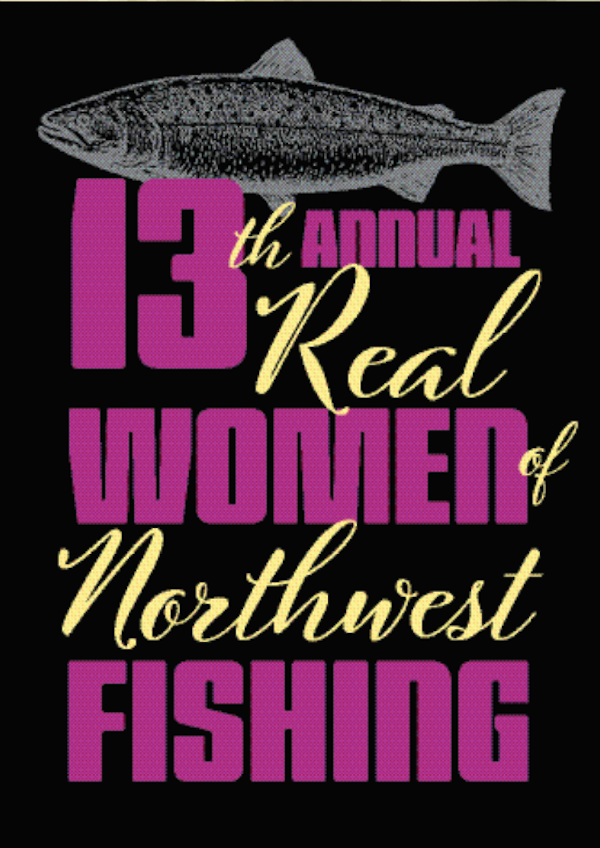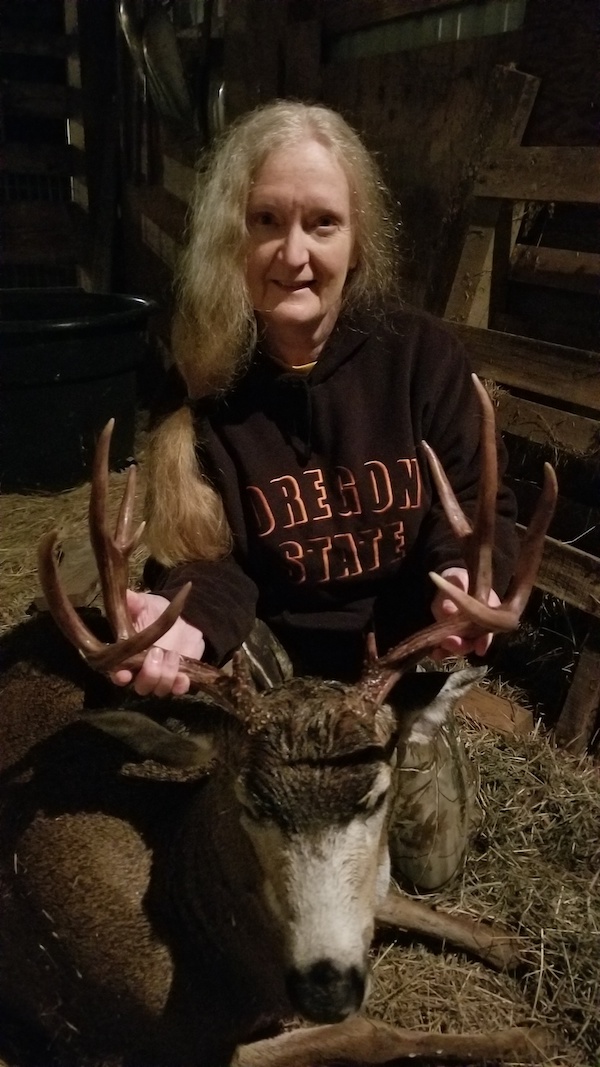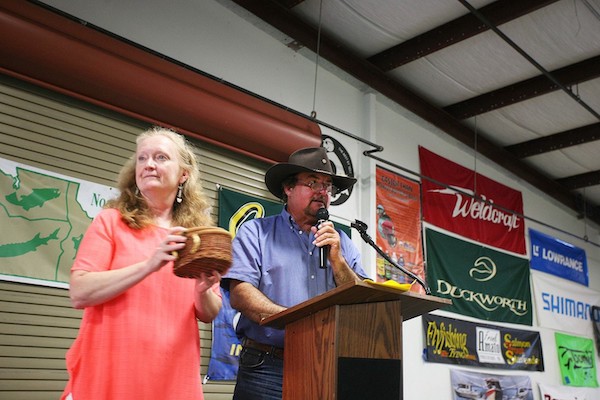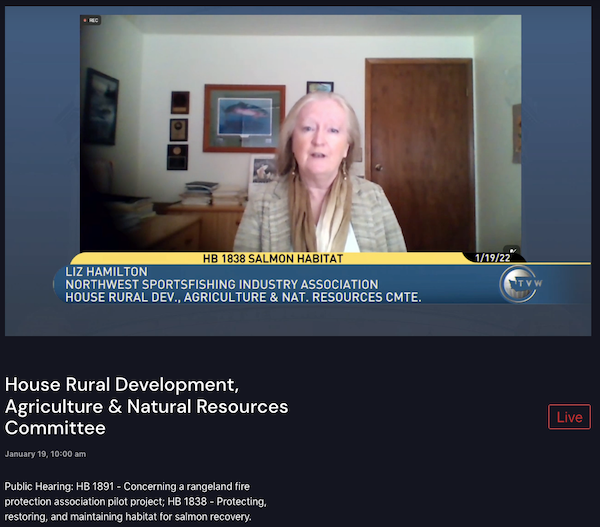
Real Women Of NW Fishing: Liz Hamilton – Angler, Advocate
Editor’s note: The following story appears in the December 2022 issue of Northwest Sportsman Magazine as part of our 13th annual Real Women of Northwest Fishing feature.
By Buzz Ramsey
Liz Hamilton is first and foremost in love with the outdoor harvest experience of fishing and – perhaps surprising to some – hunting, along with collecting other edible bounty available from the Northwest’s natural world. It all started for her as a young girl fishing for trout with her father. She remembers other fishing experiences while away at summer camp and of writing letters to her mother about the fish she caught – not something most girls did or do.

Living in Oregon City during her early adult years, Liz became aware of the opportunity to catch spring Chinook from the Willamette River. To Liz, the idea of catching fish bigger than trout seemed almost too good to be true. As a young woman without a boat or tutor, Liz prowled the banks of the Willamette in the Oregon City area, where she would often cast and retrieve spinners in the waters downstream from the falls.
Although it took weeks of trying, she finally hooked a couple of salmon but lost them, as she was unaware that a strong hookset demanded that she keep her thumb on the spool of her baitcasting reel when she reefed back. Advice from another bank angler on the importance of hooksets enabled Liz to land her first spring Chinook, which turned out to be a 25-pound fish – not bad for a young woman learning the ropes on her own.

CATCHING THAT SPRINGER was life-changing for Liz, as she soon found herself chasing salmon and steelhead at every opportunity. She marveled at the life history of anadromous fish. She became addicted to the sport and as such, obsessed with catching salmon and steelhead as any young, passionate person can be. She yearned to catch steelhead and other types of salmon like coho, summer and fall Chinook, sockeye and chum, and she did.
Liz’s first fall Chinook was a 42-pounder that she caught in the tidewater section of Oregon’s Salmon River. Her first coho came on the North Fork Nehalem downstream from the hatchery located there. Because it was close to home, the Clackamas was the river she focused on for steelhead, landing 75 fish the first year she perfected her methods and combined them with her earned on-the-water knowledge of when to be where based on water conditions.
It was in 1995 that she bought her first boat, a 15-foot Smoker Craft equipped with a 15-horsepower outboard.
Her most memorable fishing trip was for spring Chinook in Tillamook Bay when, while fishing from her boat with her husband, daughter and future son-in-law, they caught five spring Chinook and a load of Dungeness crab. The bounty of this haul was almost overwhelming for Liz and she still grins with glee when talking about it.
When I asked about her biggest salmon, Liz shared her story about catching one over 50 pounds while trolling the Columbia estuary near Astoria. The Buoy 10 salmon was so big, she could hardly lift it and still doesn’t know exactly how much it weighed, as it bottomed out the 50-pound scale she had borrowed from fishing guide Eric Linde.

SINCE THEN, HER fishing adventures have branched out to include bass and other fish species. She and husband Art have drifted the John Day River for smallmouth many times.
When I interviewed Liz for this article she and Art were just leaving to hunt deer for several days in Oregon’s Cascade Mountains. I knew she hunted deer and elk most years but I had never asked about her experiences. She shared with me the story about her first buck, which she harvested while on a drift boat trip down the lower Rogue River. The rifle she uses is a mild-recoil Tica in .308. Her hunting is usually a combo trip, as she likes to find mushrooms, huckleberries and truffles too while afield.

Her first elk, a cow, came from Douglas County’s Tioga Unit.
“I will never forget cutting up my first elk and putting all that healthy, sustainable, antibiotic-free meat in the freezer. It’s such a feeling of accomplishment to hunt and harvest your own meat instead of buying it from a grocery store,” Liz shared.
What advice does she have for women and girls wanting to get involved in fishing or hunting?
“I know only too well that fishing and hunting can be pretty intimidating for someone who hasn’t done it before, especially a female. But women who have the desire to participate can up their learning curve by meeting and talking to anglers and hunters they meet at various events such as sport shows, joining or attending a local fishing and hunting club meeting, attending how-to seminars put on by fish and wildlife agencies, or following groups like Becoming an Outdoor Woman. Think about starting with shellfish harvesting or crabbing,” Liz suggests.

“Of course, hunting requires participants to pass a hunter safety class, which is also a place where women can meet others with similar interests. Not to be overlooked is the fishing and hunting information available on the websites of state fish and wildlife agencies. A good place to get a feel for the different outdoor opportunities and the seasonality might be to subscribing to publication like Northwest Sportsman or other magazines,” Liz adds.
IN HER PROFESSIONAL life, Liz is the executive director and one of the founders of the Northwest Sportfishing Industry Association and is coming up on her 30-year anniversary in that role.
NSIA is dedicated to the preservation, restoration and enhancement of sport fisheries and the businesses dependent upon them. As such, the organization has 12 board members that represent the views of the industry and share a keen understanding of the need to weigh in on local, state, regional and federal government policies.

In addition, NSIA has a science and policy wing that advises the players within the organization, including Liz, in regard to the science and long-term impact of various threats and the ultimate positions the organization takes on different issues.
In her role, Liz manages a small office staff and a lobbyist in both Salem and Olympia. It’s the lobbyist’s job to monitor what is going on in the legislature, influence policy that benefits sportfishing and advise Liz and the board of possible threats. Being a board member, I can tell you that Liz’s role is not a 9-to-5 job, but instead one that often involves long hours and weekend work. But she’s driven by her strong passion to protect the habitats fish depend on for survival. As such, NSIA fights for both hatchery and wild fish. Currently she is working to secure an $800 million hatchery maintenance budget.
As a 45-year veteran of the fishing tackle industry and NSIA board member, I can tell you that NSIA’s political advantage often amounts to the fact that it represents jobs in the eyes of state and federal legislators, thanks to the many businesses and jobs the organization represents.
Eschewing Facebook and other internet platforms, she prefers to work face to face and bend ears. In order to enlighten political leaders and agency heads to our sport and the economic importance of fisheries, Liz has arranged fishing trips for governors, lieutenant governors and politicians like Norm Dicks, Peter DeFazio, David Wu, state senators in both Oregon and Washington, National Marine Fisheries Service directors, key staffers for elected officials, Fish and Wildlife Commission chairs – pretty much anyone she can educate on the cultural, environmental and economic benefits of sportfishing. Her favorite PR trip was with Oregon state Senator Fred Girod and his wife Lori.
“They both love to fish and were a joy to be with,” Liz shares.
AS YOU MAY know, fish hatcheries have been under attack in recent decades and NSIA has worked tirelessly in support of hatcheries and increases in hatchery production while working to deliver essential safeguards for wild fish. One big win on the Columbia River is that funding for Mitchell Act hatcheries has been increased by $1 million for 2022, thanks in part to Liz’s efforts working both sides of the political spectrum. Last year, Liz worked to secure $400 million in federal hatchery funding in Washington.
In case you don’t know, the Mitchell Act was authorized by Congress in 1938 to provide funds for hatchery programs and fish passage facilities to mitigate for declining salmon populations due to irrigation diversions, water pollution, logging and hydropower development in the Columbia River Basin. However, the funding and whether it will keep up with inflation is up for debate and must be approved by Congress each and every year. Often unseen and therefore underappreciated is the time Liz puts in influencing this and other federal issues affecting salmon.

Thanks to Liz’s energy, dedication and support from her board, NSIA has been able to tackle some giant goals on behalf of salmon, like reducing the impact marine mammals have on the fish, reducing the commercial share of salmon to the benefit of sport anglers, and opening up access to habitats blocked by dams.
To me and many of her admirers, Liz is the most consequential single person in sportfishing advocacy over the past several decades. No other single person has done more, logged more successes or been on the front lines longer than Liz. She has been involved in every major fisheries decision in Northwest salmon and steelhead over the past 30 years. She is regularly contacted by state and federal officials to weigh in on developments and changes to fisheries management, including the Office of the President and several state governors.
I can think of no better person to be represented on these pages than Northwest outdoorswoman and fish and sportfishing advocate Liz Hamilton.
Editor’s note: Buzz Ramsey is regarded as a trout, steelhead and salmon sport fishing authority and proficient lure and fishing rod designer. He has been honored into the Hall of Fame for the Association of Northwest Steelheaders and the national Fresh Water Fishing Hall of Fame.

